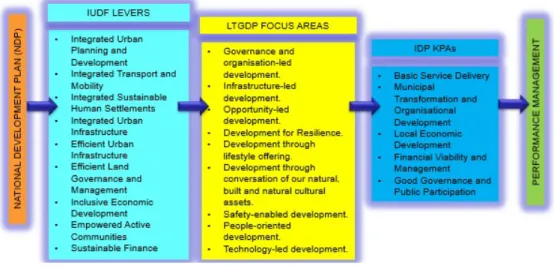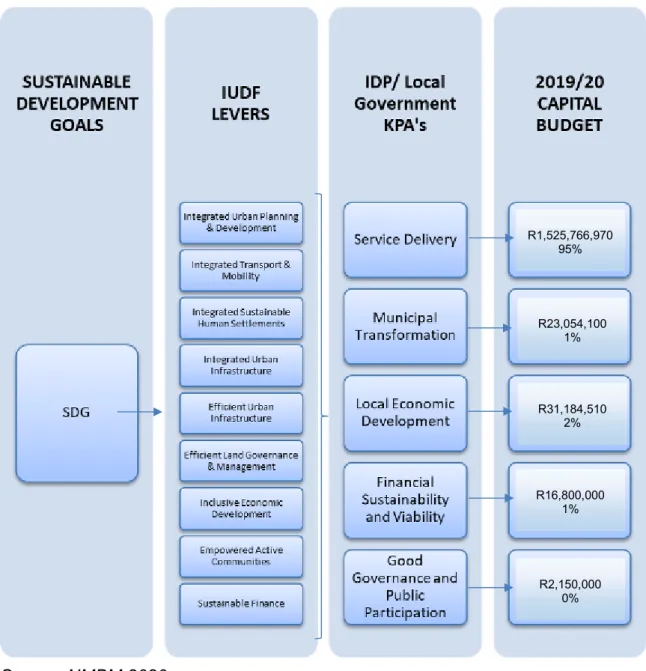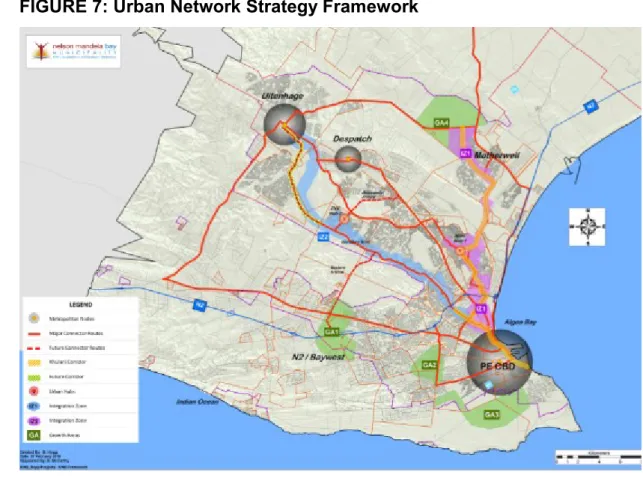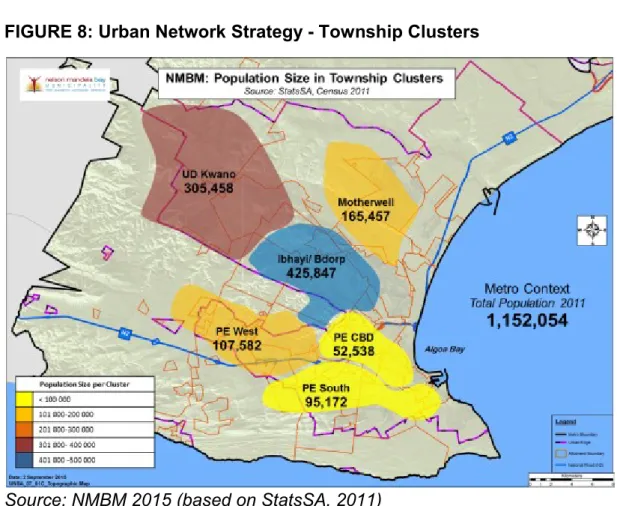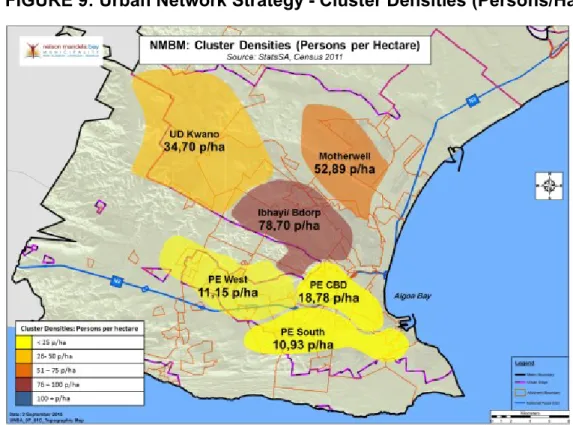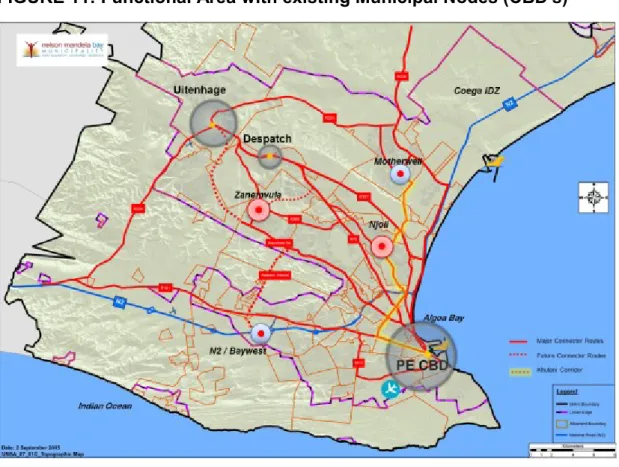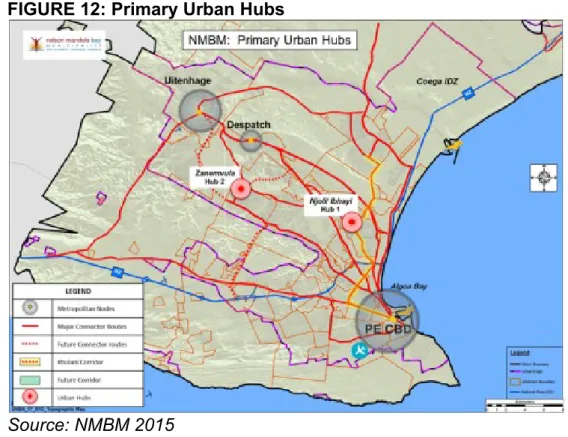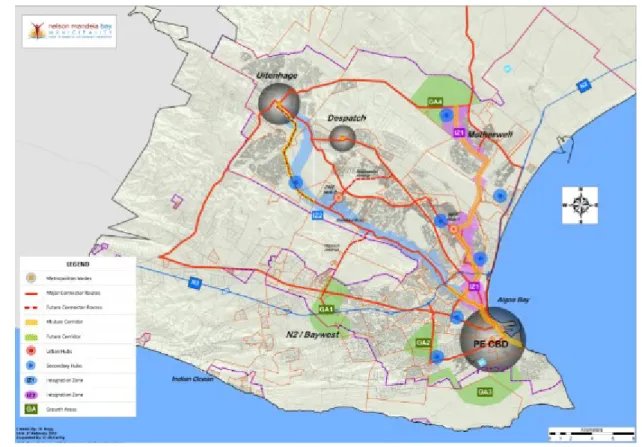APPENDIX "A" Guidance note: Framework for the formulation of Built Environmental Plans (PEPP); Supplementary guidance note for built environment performance plans (BEPP National Treasury, Cities Support Programme); Supplementary Guidance Note for the Built Environment Performance Plan (BEPP. APPENDIX “L” Built Environment Results Indicators and Objectives APPENDIX “M” 2020/21 Urban Settlement Development Grant Plan APPENDIX “N” Action Plan for Reform of Doing Business APPENDIX Assessment Framework - Self-Assessment.
INTRODUCTION
INTRODUCTION TO NELSON MANDELA BAY
- T HE R EGIONAL C ONTEXT
- S TRATEGIC D EVELOPMENT R EVIEW (SDR)
- S ITUATIONAL A NALYSIS OF THE NMBM B UILT E NVIRONMENT , 2019
- C LIMATE C HANGE C ITY P ROFILE AND R ISKS
The city has an international airport within five minutes of the city center. Currently, the city remains in the throes of one of the longest droughts it has ever experienced.
INSTITUTIONALISING THE BUILT ENVIRONMENT PERFORMANCE
- P URPOSE OF THE BEPP
- A DOPTION OF THE BEPP BY C OUNCIL
- P LANNING A LIGNMENT E XTERNAL AND I NTERNAL : SDG’S, IUDF,
- A LIGNMENT OF BEPP, IDP AND MSDF
- F OSTERING ALIGNMENT AND TRANSVERSAL ARRANGEMENTS FOR BEPP
Ensuring adaptation of the long-term growth and development plan, the long-term financial plan, BEPP, IDP and budget. The BEPP is prepared in the Chief Operating Officer's office by the Integrated City Development Office – Strategic Planning and Coordination.
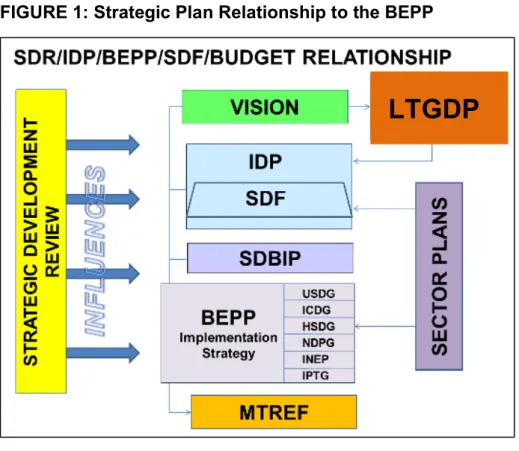
CRITICAL ANALYSIS OF THE EFFECTIVENESS OF TRANSVERSAL
By incorporating aspects of performance management, management will have to take its responsibilities in this regard more seriously. Cross-cutting arrangements for the institutionalization of the sub-national Doing Business program were launched in March 2020 and will demonstrate good practice in this regard.
SPATIAL TARGETING AND PLANNING FOR PRIORITY SPATIAL
SPATIAL DEVELOPMENT STRATEGY
The identification of the groups aided the analysis required for the development of the Urban Network Strategy. This expansion is reflected in the current planning of the Jachtvlakte / Kwanobuhle Estate residential developments. The following figure illustrates the location of the two prioritized integration zones and growth areas in the city.
The entire Housing Program is included in the Human Settlements Sector Plan of the Municipality. Annex "J", the Inter-Governmental Project Pipeline Matrix, contains a detailed list and description of all the public and private projects that exist, or are expected, for these growth areas/ economic nodes. It is the intention of the Municipality to finance this bulk infrastructure in the medium term.
The map below shows the location of the Integration Zones in relation to the housing project areas. The National Department of Human Settlements launched a program in 2015 to identify what have been called "Mega Catalytic Projects." The intention was to develop housing opportunities on a large scale in various locations around South Africa through the selection and prioritization of selected projects nominated by municipalities, provinces and the private sector.
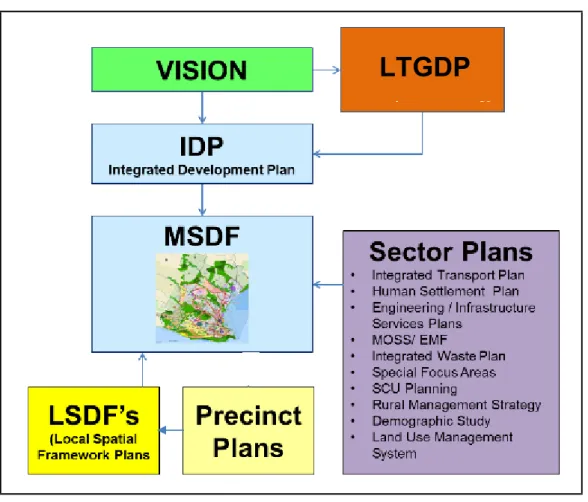
SPATIAL TARGETING AND CLIMATE RISK AND RESILIENCE
The aforementioned Climate Change and Green Economy Action Plan (CC&GEAP) has established that effective governance is the most cost-effective route to climate resilience. Application at project level of the bioregional plan and the action plan for climate change and green economy. Along with the above mechanisms, further cooperation and transversal management of climate risks occur alongside spatial planning and targeting.
It is important to emphasize that the municipality does not issue environmental approvals, but comments on applications for implementation sent to the issuing authority (DEDEAT). It is therefore important that these platforms are used to streamline climate change response into planning. This spatial representation of flood-prone and at-risk areas in the municipality helps planners and operational officials create climate-resilient buildings and informs decision-making for services that support development.
INSTITUTIONAL ARRANGEMENTS FOR SPATIAL PLANNING AND
In addition to the above – the reporting on the catalytic program has centered on the preparation of a series of templates corresponding to each program. These templates highlight combined sectoral responsibilities for the identified program and are also introduced to ensure that all directorates in NMBM are aware of the programs and are able to identify their role in the programme.
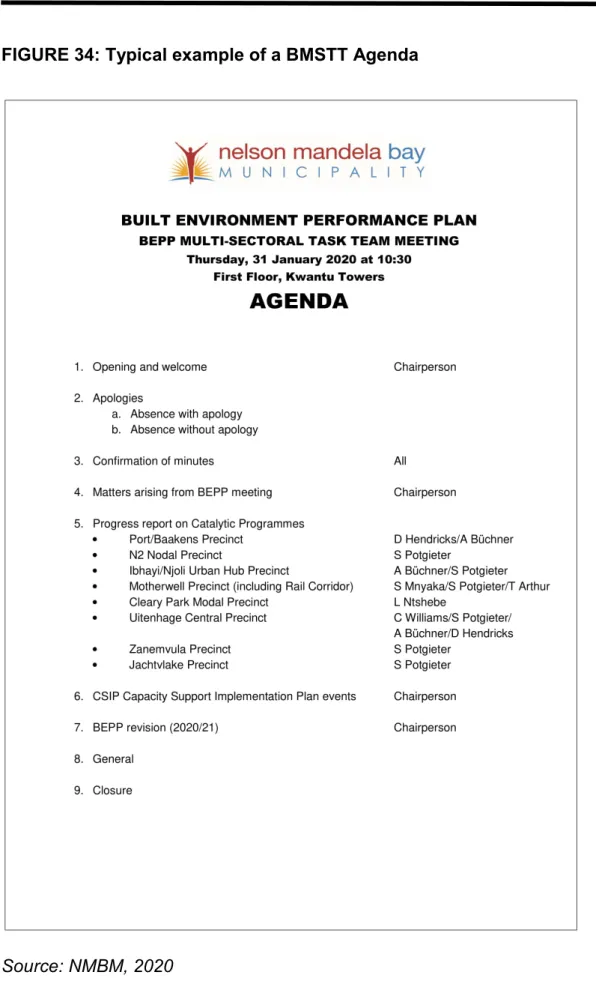
INSTITUTIONAL ARRANGEMENTS AND DISASTER RISK
The amended Disaster Management Act (2015) also contains a clause requiring that risks arising from climate change be addressed. In terms of the "Let's Respond Toolkit" developed for South African municipalities, the municipality has historically taken an alternative approach to integrating response to climate change. Meetings of the Climate Change Working Group are attended by an official from the Directorate of Public Health.
The function for climate change should be taken into account in the proposed new functional organogram of the municipality. Climate change is being reversed by gradually incorporating climate change requirements into legislation. Thus, strategic-level governance and associated leadership and front-runners ('champions') would ensure the integration of climate change considerations into the city's development thinking.
CATALYTIC URBAN DEVELOPMENT PROGRAMME
PROGRAMME PREPARATION
The BEPP Situation Analysis Section on Built Environment Trends (Appendix "C") shows a sluggish economy with little investment in the private sector. The time critical processes such as EIAs, infrastructure assessments and other expert reports take to complete before costs and viability can be finalised. The attainment of the total funding necessary for holistic development, including civic amenities and facilities such as parks and recreational areas, street lighting, tarred roads, schools and clinics.
The timing of the provision of services and facilities to be provided by other spheres of government to suit NMBM's development objectives. The lack of interest by the private sector to invest in municipal project areas. The catalytic programs are evaluated by the City Support Program and assisted by expert assistance offered under the Program.
INTERGOVERNMENTAL PROJECT PIPELINE
This and other wastewater treatment works are critical (socially and . economically) to further growth and development in the Metro, not to mention support for the Kova Eradication Program. Council approved the Inner City Area as a significant area for the purposes of Residential Infill Development; Urban Regeneration and Integrated Residential Development. The re-planning and re-engineering of Summerstrand Extension 14, for the purpose of Integrated Housing Development is underway.
PICC provides a coordination function for all projects identified at the local level and does not provide any finance for project implementation. All projects identified in the three current SIPs for NMBM are part of the current and future budget cycles. The budget available for the implementation of the various phases is based on the priorities identified in the IDP, environmental issues and legislative requirements.
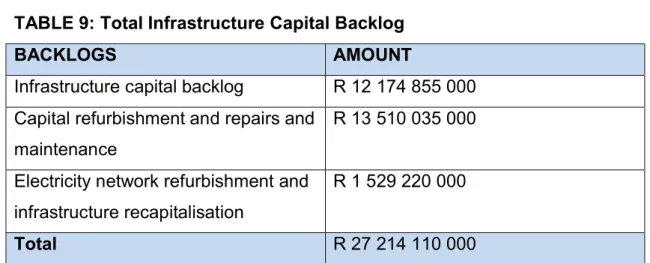
INSTITUTIONAL ARRANGEMENTS
- L EADERSHIP AND G OOD G OVERNANCE
- I NTER - SECTORAL M UNICIPAL P ROVINCIAL , SOC, N ATIONAL
- R ISK M ITIGATION
A preliminary assessment of the NMBM status quo has been made on the basis of a set of completed questionnaires. Particular emphasis has been placed on increasing stakeholder understanding of NMBM planning and aligning investments within the city's strategic planning framework. Engagements with SANRAL – the implementing arm of the Ministry of Transport – have taken place through a forum established for interaction with SOCs and others, including Transnet.
This project started in May 2017 and will continue until May 2019. The total cost is 360 million Ran. Prior to the outbreak of COVID-19, ACSA was committed to ensuring Port Elizabeth International Airport grew in line with regional demand. A total of 425 educational and 61 health projects are grouped into zones dedicated to NMBM BEPP catalytic programs.

INVESTMENT STRATEGIES, RESOURCING PLAN AND
LONG-TERM FINANCIAL SUSTAINABILITY STRATEGY
Initially it was intended to use the 2015/16 financial statements to provide the base data, but there were numerous changes to the NMBM Chart of Accounts to align it with the new mSCOA (Municipal Standard Chart of Accounts) requirements as prescribed by the National Treasury. After consultation with INCA it was agreed that it would be preferable to use the audited financial statements for 2016/17 to fill in the model base data requirements. This decision naturally caused a delay in finalizing the development of the model, but it will ultimately produce more accurate projections in the future.
The current status is that the Budget and Finance Directorate, in collaboration with INCA, is in the process of verifying and filling in the data that is required to be encapsulated in the model to ensure that the projections and forecasts when using the model are as accurate as possible. A number of readjustments must be made to comply with mSCOA version 6.3 for both revenue and expense categories. The model data population is intended to be complete by the end of 2020.
RESOURCING THE PROJECT PIPELINE/SPATIAL BUDGET MIX
The development priorities are illustrated in the NMBM IDP, which is guided by the Long-Term Growth and Development Plan. These are then captured and further expressed through the distribution of funding priorities in terms of the Capital Budget 2020/2021. The following tables have been prepared with the budget for projects in the sections of the Priority Areas and Urban Network Strategy areas.
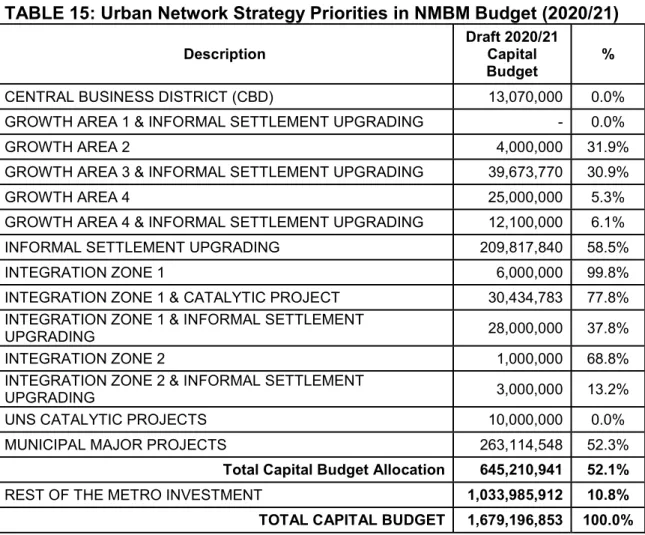
INVESTMENT STRATEGY
- A PPLICATION OF G RANT A LLOCATIONS
- P ROPOSED U RBAN S ETTLEMENTS D EVELOPMENT G RANT P LAN
The NMBM applies its grant funding (USDG) for the development of infrastructure that supports the Housing Programme. With this as background, it also formed the basis of the NMBM adopted approach to bucket eradication through, among other things, the establishment of integrated human settlements, in terms of which communities are moved from stressful situations to subsidized houses (HSDG) with water-borne sanitation. The challenge is the misalignment of the USDG and the HSDG in that the HSDG subsidies do not keep pace with available serviced sites.
As previously mentioned, the required COVID-19 densification program currently utilizes a portion of the above 5000 serviced locations. In accordance with the requirements of the Tax Sharing Act and the National Department of Human Settlements, the Urban Development Grant Plan for 2020/21 is attached as Appendix "M". The following plan shows the location of projects reflected in the grant plan for the development of cities.
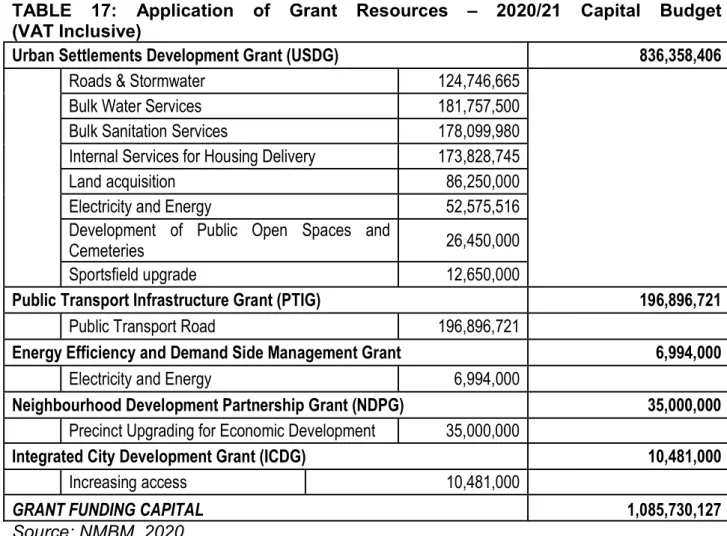
VALUE OF PROGRAMMES AND PROJECTS BY SECTOR
INSTITUTIONAL ARRANGEMENTS
With the replacement of the IDP and Budget Steering Committee by the Strategic Planning Steering Committee, the previous timetable of IDP and Budget activities was replaced by a strategic planning schedule. This timeline includes the dates of the Strategic Planning Steering Committee meetings and further provides for three strategic planning workshops at critical times of the annual planning and budgeting cycle where key strategic decisions are made. In addition, the Timetable was submitted to Council for approval before August 2018 for early preparation for the financial year programme.
Political and administrative changes halted progress in the work and workshops of the Strategic Planning Steering Committee since September 2018, as a new committee needed to be appointed, terms of reference agreed, and initiatives, functions and the importance of strategic planning presented. In November 2019, a workshop was held where they agreed on important issues of strategic planning and coordination. At the Strategic Planning Steering Committee workshop held in November 2019, the political leadership decided to acquire a capital prioritization model.
LAND RELEASE, PROCUREMENT AND REGULATORY REFORM
LAND ASSEMBLY AND RELEASE STRATEGY
PROCUREMENT APPROACH FOR CATALYTIC URBAN
REGULATORY REFORM PROGRAMME
INSTITUTIONAL ARRANGEMENTS
- C APITAL P ROGRAMME
- C APACITY S UPPORT I MPLEMENTATION P LAN (CSIP)
URBAN MANAGEMENT AND INSTITUTIONAL ARRANGEMENTS
URBAN MANAGEMENT INTERVENTIONS
INSTITUTIONAL ARRANGEMENTS AND OPERATING BUDGET
CONSOLIDATED OPERATING BUDGET
BUILT ENVIRONMENT OUTCOME INDICATORS AND TARGETS AND
BUILT ENVIRONMENT OUTCOME INDICATORS AND TARGETS
THEORY OF CHANGE
BIBLIOGRAPHY
